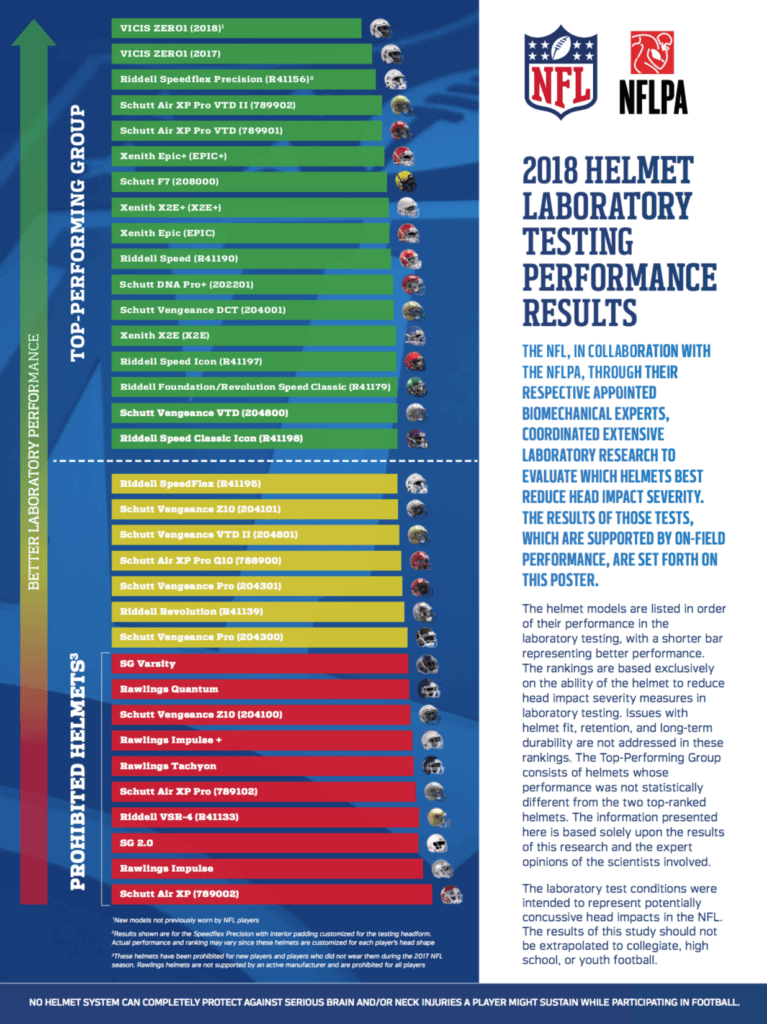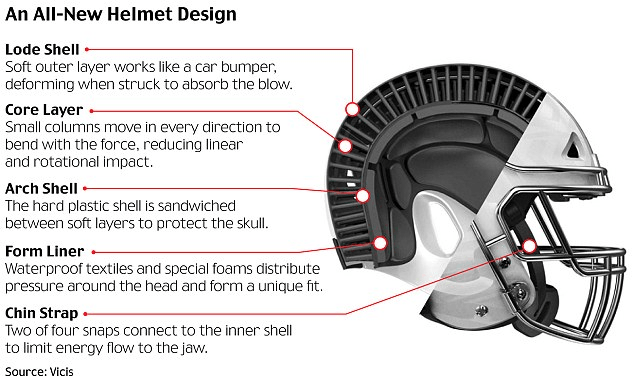Will the Sport of Football Survive? VICIS Says Yes.
Can additive manufacturing help a helmet company named VICIS save the sport of football from going extinct?
Chris Borland recorded 107 tackles with 2 interceptions as a standout rookie linebacker. He then retired at the age of 24 and instantly became “the most dangerous man in football.”[i]
Borland was one of the first high profile NFL players to retire proactively due to the risk of Chronic Traumatic Encephalopathy (CTE) and forced the sport of football to confront its harmful impact on players’ lives. CTE is a potentially fatal neurodegenerative disease that is more prevalent in football players due to the repeated blows to the head suffered during the sport.[ii] Over the last decade, players have begun to taken notice of CTE. The number of high school football players has decreased 7% over the last decade as youth players and families avoid the sport.[iii] So, can football be fixed?
A new helmet company called VICIS says yes. VICIS, with the help of 3D printing, is mitigating the impact of hits to the head. 3D printing is a type of additive manufacturing that can help companies design products more effectively with fewer costs and shorter production time. Through iterative prototyping with 3D printing, VICIS has used innovative techniques to create what is now ranked the safest helmet in the NFL (Figure 1). The VICIS ZERO1 is a multi-layered helmet with a soft outer shell and hard interior (Figure 2) that slows the impact of a hit to the helmet and decreases the force to a player’s head.[iv]
Thus far, 3D printing has been vital to VICIS’s speed to market as alterations that typically would take three weeks are completed in two to three days.[v] The ability to iterate quickly has allowed VICIS to not only rely on engineers, but also take the advice of neurosurgeons, concussion specialists, and former NFL team physicians to constantly reimagine the design of a football helmet.[vi] As the company moves forward, additive manufacturing will be critical in continuing to improve the safety of helmets, while making them more accessible to football teams across the nation.
In the short term, VICIS is capitalizing on additive manufacturing to rapidly prototype and create increasingly safer helmets. Additive manufacturing has also marginally brought down costs in the helmet’s selling price. While the current $950 price tag of their VICIS ZERO1 helmet is still more than 3x the price of a standard helmet, this price is a major decrease from the initial $1,500.[vii] They are also releasing a youth league helmet for $495 in 2019 in an effort to bring desperately needed safety to a new generation of football players.
In order to stay relevant in the medium term and continue to optimize its production process, VICIS is making sure to constantly “experiment with 3D printing and other emerging fabrication methods.”[viii]
My first recommendation would be to decrease the price now in order to reach a wider audience. While NFL players may be at the most risk, even young children playing contact football immediately are at increased risk of CTE. If VICIS wants to make a high social impact, VICIS must confront its high price relative to what youth teams can afford. In addition to increasing their social impact, they will generate high brand awareness potentially solidifying themselves as the helmet of the future. In the medium term, if VICIS succeeds in implementing 3D printing in their production line, they will be able to increase margins as manufacturing costs decrease dramatically.
I also would recommend VICIS capitalize on their unique ability to collect data on in-game helmet hits. If they can figure out how to extract and capitalize on this data, they will be able to create even safer products.
The question moving forward is, will VICIS be enough to keep football from going extinct? And if football goes extinct, where can VICIS bring their innovative technology?
(Words: 798)
Figure 1: The Safest Helmet in Football
Source: “Helmet Laboratory Testing Performance Results.” NFL, https://www.playsmartplaysafe.com/resource/helmet-laboratory-testing-performance-results/, accessed November, 2018.
Figure 2: Disrupting the Helmet Business
Source: Gruley, Brian and Robinson, Peter, “This Football Helmet Crumples— and That’s a Good Thing.” Bloomberg. January 11, 2016, https://www.bloomberg.com/features/2016-vicis-football-helmet/, accessed November 2018.
[i] Fainaru, Steve and Fainaru-Wada, Mark, “Why former 49er Chris Borland is the most dangerous man in football.” ESPN, August 20, 2015, http://www.espn.com/nfl/story/_/id/13463272/how-former-san-francisco-49ers-chris-borland-retirement-change-nfl-forever, accessed November 2018.
[ii] Omalu, Bennet L., “Chronic traumatic encephalopathy (CTE) in a National Football League Player: Case report and emerging medicolegal practice questions.” Journal of Forensic Nursing (February 22, 2010): 1.
[iii] Kroichick, Ron, “Tomorrow’s Game: What will football look like in 20 or 30 years? You might not recognize it.” SF Chronicle, https://www.sfchronicle.com/sports/article/The-future-of-football-What-will-the-game-look-13319246.php, accessed November 2018.
[iv] Gruley, Brian and Robinson, Peter, “This Football Helmet Crumples— and That’s a Good Thing.” Bloomberg. January 11, 2016, https://www.bloomberg.com/features/2016-vicis-football-helmet/, accessed November 2018.
[v] Baldwin, Jessamy, “The VICIS ZERO1: Engineering a Safer Football Helmet.” GrabCAD Blog. October 3, 2017, https://blog.grabcad.com/blog/2017/10/03/the-engineering-behind-the-football-helmet-that-wants-to-make-the-game-safer/, accessed November 2018.
[vi] Baldwin, Jessamy, “The VICIS ZERO1: Engineering a Safer Football Helmet.” GrabCAD Blog. October 3, 2017, https://blog.grabcad.com/blog/2017/10/03/the-engineering-behind-the-football-helmet-that-wants-to-make-the-game-safer/, accessed November 2018.
[vii] Glatter, Robert, “Experimental Helmet Aims to Fix Football.” Forbes, February 6, 2016, https://www.forbes.com/sites/robertglatter/2016/02/06/can-this-helmet-make-football-safer/#71789fce28e6, accessed November 2018.
[viii] Glatter, Robert, “Experimental Helmet Aims to Fix Football.” Forbes, February 6, 2016, https://www.forbes.com/sites/robertglatter/2016/02/06/can-this-helmet-make-football-safer/#71789fce28e6, accessed November 2018.



Great submission! I was quite surprised that they ended up with a soft shell on the outside, that will certainly do away with the crack of the hit we’re used to hearing. I wonder whether or not AM will end up being cheaper in the end once they have perfected their design. Could it really be cheaper to use hundreds of AM machines than to produce molds and manufacture in a low-cost country? It seems to me that this application may stay limited to ultra-fast prototyping in this context. However, I could imagine that as 3D printing goes mainstream, you could get a new helmet printed at the local printer before heading to your new game. Also, I actually think the price is quite reasonable. It’s highly likely that schools and even youth leagues will be willing to shell out to protect their kids.
Bueller, I worry about price of VICIS especially as it starts expanding into the youth segment. There are over one million kids in the US between the ages of 6-12 that play tackle football. A 3X price premium could slow adoption into that market. A challenge with additively manufacturing lower priced goods is that it takes huge volumes to offset the fixed costs of the machine, maintenance, and engineering staff required. Once R&D cycle is complete for VICIS, it could revert to traditional manufacturing as a cost savings.
I think VICIS can make a big impact on football but in order to do so they need to go mainstream. If the NFL rated it the #1 safest helmet, why is playing with this helmet not mandatory? I would urge the NFL to form a partnership with VICIS and subsidize the cost of these helmets for players or even provide them for free. I see that the price is prohibitive but the NFL needs to give away some of their profits and protect the health of their players. In 2017, NFL teams’ revenue exceeded $8B. With this being said, I think they are morally obligated to provide these helmets for players and do everything possible to reduce the risk of CTE.
This was a very interesting piece and VICIS is addressing an issue that certainly demands a lot of attention today. In my opinion, the price is the most concerning barrier to adoption. Within that 7% decline in the number of high school football players over the past decade, the declines are much greater in higher income areas which would have a greater ability to pay for these helmets. As the sport continues to skew towards lower income communities at the youth and high school level, affordability will become an increasingly important issue. I am definitely encouraged by the early cost improvements that VICIS has realized, and I hope that we continue to see those come down in the future.
Thank you for an interesting post!! This was inspiring to me in terms of how the advanced/new technology can make social impact. I definitely agree that VICIS is innovative and impactful, and it is a matter of “support” from organizations, consumers, governments, etc., who feel sympathy with this product and who try to change the situation by advocating this. Once PR activity did its job and more and more people get to know about it, I think VICIS will have a future where they can price it lower and spread the product across, by achieving the volume target to do so.
Really interesting submission, Bueller!
I tend to disagree with the idea that they should be marketing it to NFL players. The main differentiation factor of this product is safety. Who cares more about safety? Moms & dads. They should be focusing their efforts in lowering the price of the helmet -and I’m sure there is room for that- and targeting youth players. If you are going to save the sport, you need to start with the young players, and this helmet has the potential to directly address the biggest concerns that families have when it comes to the sport their kids play.
p.s. I would be interested to see how the helmet ranks not only in relative terms to other helmets, but in absolute terms. How safe is the safest helmet in the market? Is it safe enough?